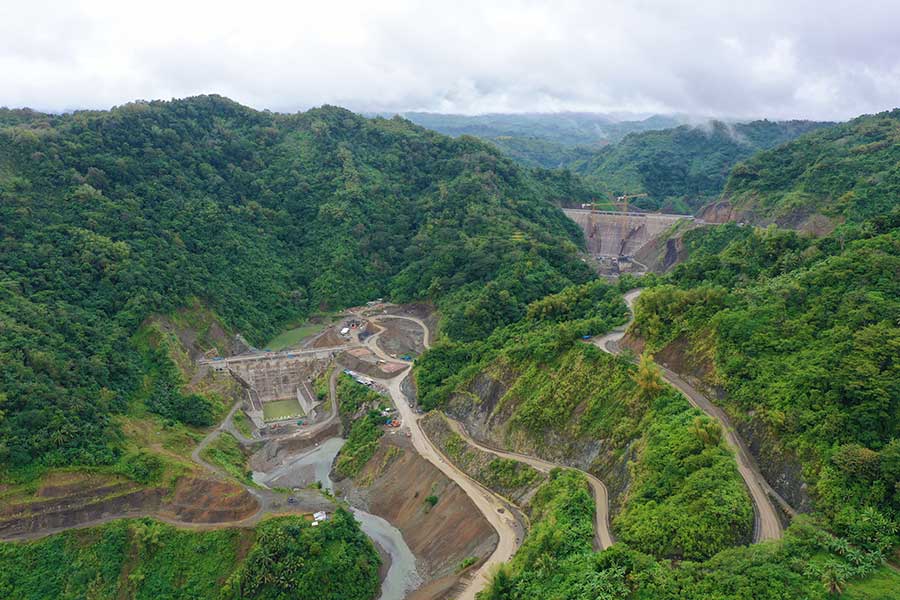
By Joseph Bernard A. Marzan
The long-anticipated Jalaur River Multipurpose Project Stage II (JRMP II) is on track to open in 2025, with all major structures completed and final preparations underway for its impending operation.
JRMP II spokesperson Steve Cordero reported to Daily Guardian on Air on Friday, March 1, that the project boasts a 74.07 percent completion rate as of January 2024, leaping from just over 60 percent in November 2023.
All three dams, including the 109-meter Jalaur High Dam, the 38.5-meter Jalaur Afterbay Dam, and the 10-meter Alibunan Catchment Dam, have been substantially completed.
The Jalaur High Dam saw its final concrete pouring on November 27, 2023, while the Afterbay and Alibunan dams reached substantial completion in February 2023 and December 2021, respectively.
Current works are focused on slope preparation behind the High Dam to prevent siltation and vegetation growth, along with the installation of electromechanical systems and railings that will bridge the riverbanks.
Upon completion, the dam will supply water to the 1st through 4th legislative districts of Iloilo province and Iloilo City.
The Jalaur Afterbay Dam will extend irrigation to Tigbauan town, and the Alibunan Catchment Dam will serve areas in Calinog, Passi City, and part of Lambunao town.
“Once fully operational, the project can irrigate new areas totaling 9,500 hectares. To cover this, additional water sources are needed for parts of Calinog and Passi City, and one barangay in Lambunao,” Cordero said.
Rice farmers, especially within Calinog and Lambunao, stand to benefit significantly, with potential coverage extending to 31,840 hectares of farmland.
“[The JRMP II] can contribute significantly in terms of rice production. The target service area can only plant [rice] once in a year, specifically in portions of Calinog and Lambunao where there aren’t any major irrigation development activities yet. With the project’s completion, areas that currently plant rice only once a year can increase to twice annually, as there will be a reliable water supply,” Cordero added.
Also ready are the penstock for hydroelectric power and facilities for bulk water, with their operations contingent on processes by the National Irrigation Administration (NIA), the project’s implementing agency.
According to NIA Memorandum Circular No. 2023-132, a Lease Agreement Selection Committee (LASC) is to be formed at the agency’s central office to manage proposals for the hydroelectric and bulk water aspects of JRMP II, with Acting NIA Regional Manager and JRMP II Project Manager Jonel Borres serving on the LASC.
Metro Iloilo Water District has shown interest in the project’s bulk water supply, which is projected to provide 86.4 million liters, complemented by a 6.6-megawatt hydroelectric capacity.
However, Road Right of Way (RROW) issues persist, with the lowland RROW at only 20 to 30 percent completion due to rigorous documentation required under The Right-of-Way Act.
“Obtaining documents for compensation is a meticulous process, especially when dealing with ownership proofs dating back to the American period,” Cordero explained.
The upland RROW is near completion at 90 percent, with 32 Indigenous Peoples/Indigenous Cultural Community (IP/ICC) families already relocated to accommodate the reservoir lake.
The acquisition process is unique here, as the land involves Ancestral Domains requiring consent under the Indigenous Peoples Rights Act of 1997.
Cordero also noted that IP/ICCs are actively involved in watershed management and eco-tourism initiatives in partnership with the NIA and the Department of Environment and Natural Resources.
Tracing its inception back to Republic Act No. 2651, enacted by President Carlos P. Garcia on June 18, 1960, the JRMP’s first phase was completed in the 1980s, with the second phase kickstarting in 2012.




















